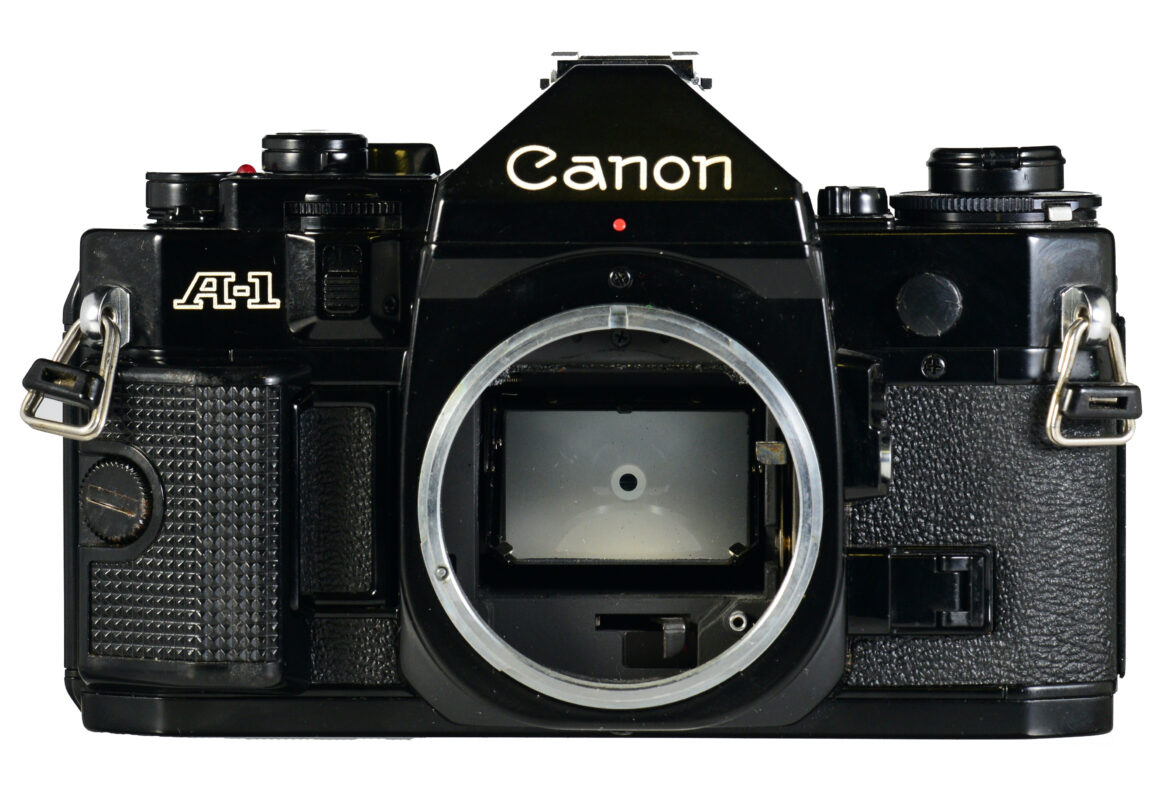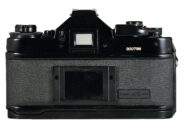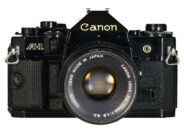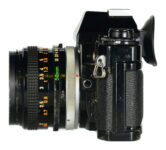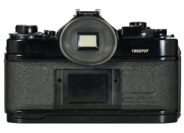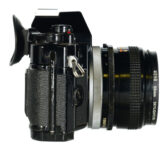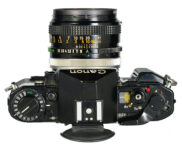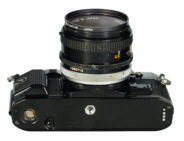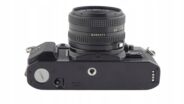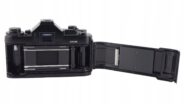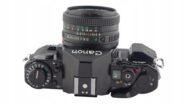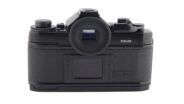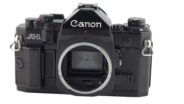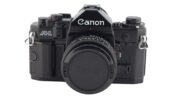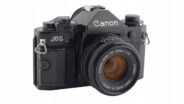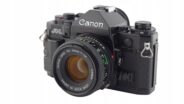Canon A-1
35mm MF film SLR camera
Specification
| Production details: | |
| Announced: | April 1978 |
| System: | ● Canon FD (1971) |
| Format: | |
| Maximum format: | 35mm full frame |
| Film type: | 135 cartridge-loaded film |
| Mount and Flange focal distance: | Canon FD [42mm] |
| Shutter: | |
| Type: | Focal-plane |
| Model: | Electronically controlled |
| Speeds: | 30 - 1/1000 + B |
| Exposure: | |
| Exposure metering: | Through-the-lens (TTL), open-aperture |
| Exposure modes: | Programmed Auto |
| Aperture-priority Auto | |
| Shutter-priority Auto | |
| Manual | |
| Physical characteristics: | |
| Weight: | 620g |
| Dimensions: | 141x91.5x47.5mm |
Manufacturer description #1
In April, 1976, Canon introduced a landmark camera, the Canon AE-1. It incorporated a very reliable computerized AE mechanism into a compact body that can be marketed at a very competitive price due to revolutionary production techniques. The AE-1 has been a huge success and completely changed the face of photo hardware marketing.
With the AE-1 firmly established as the best selling SLR in the World, design work progressed on a more versitile version. This work is now complete and the result is the CANON A-1, the Apex of the AE camera world: the highest quality, most durable, most feature laden automatic exposure SLR in the world.
The major goals which guided the design of the A-1 were:
- Incorporation of advanced digital technology
- Compact, easy-to-handle body
- Compatability with AE-1 system components
- Interchangeability of parts with AE-1
- Improved durability
Features
Five difference automatic exposure modes
- Full Aperture TTL Metering: Shutter speed priority AE, Aperture priority AE, Programmed AE, Electronic flash AE
- TTL Stopped-Down Metering: Stopped-down AE at (regardless of the types of lens attached or whether a lens is attached at all).
The employment of total digital system to process with speed and accuracy all incoming information
After converting the brightness information form into digital form, digital computation information input, calculation, information from analog takes care of storage, information display and exposure control.
Full Information Character Display Viewfinder
All information is displayed alphametricly is the dark area below the focusing screen by segmented LED's similar to those used in digital calculators. Information includes exposure information, mode information, and various warnings. Although it is probably the least intrusive full information viewfinder ever built, it can be turned off to completely eliminate any distraction to focusing and composition. Even when it is turned off, the camera continues to function normally in whichever mode it is in. Details are given later.
Expanded Range and Versitility
Expanded metering, film speed and shutter speed and exposure compensation ranges, EV memory and multiple exposure increase the A-1's versitility.
Essential Controls and Displays Grouped for Easy Reach and Rapid Operations
- AE mode
- AT dial
- Shutter button lock self-timer lever
- Viewfinder information display switch
- Multiple exposure lever
Automatic System Components
Motor Drive MA, Power Winder A, Data Back A, Speedlites 155A, and 199A.
Human Engineering, Miscellaneous
- Safety Features: Lock Mechanisms, Flashing Warnings, Energy Conserv ing Design
- Easy Operation: Action Grip, Human Engineering Design, Electro-magnetic release
- Interchangeable Viewfinder Screens
- Easy to read viewfinder
- True-load battery checker gives visual indication of remaining battery power
- Eyepiece Shutter to block extraneous light
- Two delay self timer
Manufacturer description #2
The A-1 was the top-of-the-line A-series camera. (The AE-1 was the first in this series.) It was a sophisticated electronic camera with all-digital control.
Besides the shutter speed-priority AE and aperture-priority AE modes, it featured the first fully automatic program AE mode, preset aperture-priority AE, and Speedlite AE mode.
The viewfinder information was also easy to read with a 7-segment red LED readout. The control settings were displayed at the same time which made it very useful.
Besides Power Winder A, developed at the same time as the AE-1, accessories for the A-1 included the compact Motor Drive MA which attained a maximum shooting speed of 5 fps. This Motor Drive had a convenient vertical-grip shutter button. Also, there was the Speedlite 199A which had bounce flash capability.The A-1’s body had a fine black finish.
Manufacturer description #3
Application of the Most Advanced Electronics for the First SLR Ever to Have Five AE Modes
The inclusion of programmable logic array in the program unit has enabled, for the first time in the world, the production of a multi-mode AE camera over which camera users can exercise their choice for every conceivable picture-taking situation. The selection of automatic exposure systems over which you can pick your choice with a simple flip of a switch are: (1) shutter-speed priority AE, (2) aperture priority AE, (3) programmed AE, (4) stopped-down AE, and (5) electronic flash AE.
The AT Dial and Its Ramifications
One of the first things you will notice about the A-1 is its absence of a shutter-speed dial. This has been replaced by the AT dial, an all-purpose device. The dial has two settings: Tv (time value) and Av (aperture value). The former is for shutter-speed priority and the latter for aperture priority. The selection among AE modes is a very simple operation - a matter only of adjusting the AE mode selector and AT dial. A complete micro-computer used in the A-1 with a micro-processor and a program unit possesses operational and program storage functions. And depending on the photographer-selected AE mode, shutter speed, aperture and all important information pertaining to exposure, including warnings and reminders, appear in the form of digital displays and alphabetical letters for instant readouts.
The Viewfinder
The use of LED digital readouts in the A-1's viewfinder (split-image/microprism rangefinder as a focusing aid) enables a lot of photographic information to be displayed, below thel field of view and out of the photographer's way. This information includes: shutter speed, aperture, 'F' indicating condenser charge completion when using Canon dedicated Speedlites, "bulb" spelled-out when using Bulb setting, 'M' indicating manual operation and EEEE EE indicating incorrect stop-down operation.
In addition, the aperture or shutter speed indicator will start flashing if the settings the user has chosen result in under- or overexposure. The shutter speed indicator will flash when aperture priority AE is in use, and vice versa.
Divided into seven segments, the degree of illumination of these displays changes in four levels to provide consistency in brilliance under contrasting lighting conditions. The displays appear the instant the shutter release button is depressed half way or the exposure preview button pushed. However, if you do not care to see the displays at all, there is a switch to cancel all the readouts. This is one of the ways to concentrate on composing the picture, unhindered.
Expanded Metering Range
The A-1 meter uses a silicon photocell placed above the eyepiece. Its range of EV -2 to 18 for f/1.4 lens and ASA 100 film speed is much greater than that of the conventional CdS cell. For a lens with the maximum aperture of f/1.4 used with ASA 100 film, a low-light limit of the metering range is 8 seconds at f/1.4 irrespective of the AE mode selected.
Six-Mode Exposure Control
1. Shutter Speed Priority
Shutter-speed priority is especially useful for stopping motion in fast-action photography. It also helps the novice prevent blur caused by camera shake or cause blur for creative effect.
This AE mode is obtained by leaving the lens' aperture ring on the 'A' mark and setting the AE mode selector on Tv (time value). The photographer sets the shutter speed and the aperture is automatically adjusted for proper exposure. In the viewfinder, the shutter speed readout will stay the same while the one for aperture will change with the lighting conditions. Available shutter speeds range from 1/1000th sec. all the way to 30 seconds.
2. Aperture Priority AE
When the photographer wishes to easily control his depth-of-field, aperture priority is recommended. With the lens' aperture ring on 'A' and the AE mode selector switched to the Av position, the photographer selects the desired aperture and the shutter speed is automatically adjusted for proper exposure. The aperture readout in the viewfinder indicates the aperture selected, while the shutter speed readout changes.
3. Programmed AE
To obtain programmed AE, the aperture ring must be left on 'A' and the AE mode selector switched to Tv. Then the shutter speed scale must be set to 'P', located above the 1/1000 sec. speed setting. Focus and shoot photography is the result as both shutter speed and aperture are automatically adjusted to give optimum exposure. Both digital readouts will change with the subjects' brightness. However, once the aperture is fully open, only the shutter speed indicator will continue to change. Extremely wide·range programmed AE is great for beginners as well as professionals, allowing the photographer to concentrate on the subject without worrying about exposure control.
4. Electronic Flash AE
To take full advantage of this mode, the more powerful Canon dedicated Speedlites, such as the 199A shoe-mount and 533G and 577G handle-mount units are recommended. They offer three-f-stop range selection, bounce-flash capability and greater Iight output for better results under a wide variety of conditions. Attaching any Canon dedicated Speedlite to the A-1 automatically sets the camera for flash photography. A special control on the above-listed Canon Speedlites allows the A-1 to be used automatically for flash photography at speeds below 1/30th second for combination flashltime exposures.
5. Stopped-Down AE
This unique mode enables AE photography with FL lenses in addition to FD lenses and this mode is also used when non-coupling accessories for photomacrography or photomicrography are placed between body and lens. When the Stopped-Down lever is pressed, the lens aperture ring is taken off 'A' and set to the desired aperture. The AE mode selector can be left in' either the Tv or Av positions, as the proper shutter speed will be automatically selected in either case. In this mode, only the shutter speed readout will appear in the viewfinder. Proper exposure may be obtained by using any lens or accessory that can be physically attached to the A-1.
6. Manual Photography
For manual photography, the AE mode selector should be set to the Tv position and shutter speeds selected manually. The aperture ring of the lens should be moved from the 'A' position to the desired aperture. Although all functions are controlled manually, the viewfinder will provide readouts of the shutter speed selected, and the suggested aperture setting for proper exposure.
ASA Film Speed Setting
Pictures can be taken in unlimited fashion with an ASA film speed range from ASA 6 to 12,800 in 12 steps click stopped in one-third increments between the cal ibrated figures. Fast ratings of ASA 800 and above are especially convenient for pushing high-speed films, when the situation demands use of fast shutter speeds in low-light conditions. The inclusion of ASA 6 and other slow ratings should be of interest to those using slow duplicating films.
Easy exposure Compensation
The A-1 offers exposure compensation of ±2 f/stops by means of a large, easy-to-use dial. With 1/3-stop increments between each flstop, precise compensation for special techniques such as low- and high-key shots and against-the-light photography is possible.
Exposure Memory Switch
Another device that facilitates exposure compensation is the exposure memory switch. The photographer takes a reading on the subject and holds in the switch while taking the photograph. The memory feature of the A-1 is unique and the camera stores exposure value data. This leaves the photographer with a complete freedom to adjust shutter speed and f/stop while holding in the memory switch, for example, from 1/500 f/2.8 to 1/30 fill for the same exposure by rotating the Tv or Av dial.
Energy-Saving Design
Only one silver oxide battery runs the A-1 for an entire year. This is possible because every part of the camera is designed to save power, from its sequence circuitry to Pure I2L and combination magnet.
Lightweight, Compact and Totally Foolproof
Extensive use of electronics has enabled the A-1 to do many things, but yet remain as compact as and just a little heavier than the AE-1. And many of the camera's controls are equipped with locking devices to prevent accidental movement.
Total Accuracy and Reliability
Accuracy and reliability have been trademarks of Canon for mtlny years. Because it employs the most up-to-date technology, the A-1 actually improves on these two points.
Technology that Made the A-1 Possible
The A-1 is a unique camera because it employs the latest technology such as PLA (programmable logic array) available from the electronics world. Both input and output information are in the form of pulse signals, thus enabling a digital computer to be used for information input, calculation, storage, display and exposure control. And with its pure I2L, used for the first time in a camera, many times the amount of information can be processed than has been previously possible. All this information is arranged in correct order by a PLA, making possible the digital displays in the viewfinder.
Digital Control
With the A-1, a full-scale digital control micro-computer with a programmable logic array has been incorporated into the camera body. Transfer of data is done by means of digital controls (quantified values by pulse signals) coupled with the programmed arithmetic functions which provide answers to conditional requirements such as lighting levels and thus takes complete control over the exposure system in each AE mode.
Manufacturer description #4
Type: 35mm SLR (Single-Lens-Reflex) camera with selective, electronically controlled AE (Automatic Exposure) and focal plane shutter.
Format: 24 x 36mm
Photographic Modes: Six modes; including five AE modes: shutter priority AE, aperture priority AE, programme AE, full AE flash photography with specified Canon electronic flashes, and stopped-down AE; and manual override.
Interchangeable Lenses: Canon FD series lenses (usable with four full aperture metering AE modes and stopped-down AE); Canon FL series lenses (usable with stopped-down AE).
Standard Lens: Canon FD 50mm lenses.
Lens Mount: Canon Breech-Lock mount. Canon FD, FL and R lenses can be mounted.
Viewfinder: Fixed eye-level pentaprism.
Field of View: 93.4% vertical and 95.3% horizontal coverage of the actual picture area.
Magnification: 0.83X at infinity with a standard 50mm lens.
Focusing Screen: Standard split-image/microprism rangefinder.
Viewfinder Information: Displayed in form of LED digital readout below viewing area. Includes shutter speed (1/1000 sec. - 30 sec.), aperture (f/1.2 - f/32), flashing warning of incorrect exposures and settings, bulb indication, charge completion indicator for specified Canon flash units, manual aperture control signal, error indication for incorrect stopping-down operation. Shutter speed and aperture data displayed in 1/2 step increments. Viewfinder information can be cancelled by turning off viewfinder display switch.
Dioptric Attachment: Built-in eyepiece is adjusted to standard -1 diopter.
Eyepiece Attachments: Angle Finders A2 and B, Magnifier S, 10 different Dioptric Adjustment Lenses S for eyesight correction and Eyecup 4S.
Eyepiece Shutter: Built-in. Keeps out extraneous light during self-timer or remote control operation.
Mirror: Instant-return type with shock absorbing mechanism. No image cut-off in the viewfinder even with the FD 400mm telephoto lens.
AE Mechanism: Electronically controlled. Information output by means of AE mode selector and AT dial for full-aperture AE metering (FD lens at "A") and stopped-down AE metering. Employs three LSI's with I2L, one Linear LSI and one Bi-MOS IC for light metering.
AE Mode Selection: By means of AE mode selector. Two settings: Tv (Time value) for shutter priority AE, Av (Aperture value) for aperture priority AE.
Light Metering System: Through-The-Lens Central Emphasis Average metering by silicon photocell located just above eyepiece lens. Light reaches silicon photocell after passing through fresnel lens condenser.
ASA Film Speed Settings: ASA 6 to ASA 12800 in 1/3 step increments. With lock.
Meter Coupling Range: EV-2 (8 sec. at f/1.4) to EV 18 (1/1000 sec. at f/16) at ASA 100 with FD 50mm f/1.4 lens.
Exposure Compensation: +/-2 f/stop range in 1/3 f/stop increments: 1/4 •• 1/2 •• 1 •• 2 •• 4.
Exposure Memory: EV locked in when exposure memory switch is pressed. When pressed, the shutter-speed/aperture combination can be changed for the same locked-in EV.
Exposure Preview: Viewfinder digital readout activated by pressing shutter button halfway or by pressing exposure preview switch or exposure memory switch.
Stop-down Lever: Foldable. Stopping-down an FD lens is possible only when aperture ring is disengaged from "A" mark.
Manual Override: Possible by disengaging FD lens from "A" mark and setting AE mode selector to Tv. Aperture manually controlled with aperture ring, shutter speed with AT dial.
Shutter: Cloth focal plane shutter with four spindles. Electronically controlled, steplessly, from 30 sec. to 1/1000 sec. Shock and noise damper mechanisms are incorporated.
Shutter Speed Scale: B, 30, 15, 8, 4, 2, 1, 2, 4, 8, 15, 30, 60, 125, 250, 500, 1000 plus P (with the AE mode selector at Tv). "P" setting is for programmed AE mode. Intermediate speeds not on the scale cannot be set.
Aperture Scale: 1.4 • 2 • 2.8 • 4 • 5.6 • 8 • 11 • 16 • 22 (with the AE mode selector at Av).
Shutter Release Button: Oversized, two-step button with electromagnetic shutter release. Pressing it halfway activates meter circuit, pressing it all the way sets shutter in operation. Can be locked by setting main switch to "L" to guard against accidental shutter release. With cable release socket.
Power Source: One 6v alkaline-manganese (Eveready [UCAR] No. A544, IEC 4LR44), silver oxide (Eveready [UCAR] No. 544, IEC 4SR44, Duracell PX 28), or lithium (Duracell PX 28L) battery. Battery lasts about one year under normal use.
Battery Check: A red LED on top of camera flashes on and off to indicate power level when battery check button is pressed. Flashing frequency decreases with power level.
Main Switch: Two positions: "A" and "L". At "L" all active circuits are off and shutter button is locked as safety feature. Doubles as self-timer lever.
Cancellation of Camera Circuit: Shutter and self-timer operation cancelled by setting main switch to "L" or by pressing battery check button.
Multiple Exposure: Possible by setting multiple exposure lever before winding film advance lever to recock shutter. Frame counter does not advance. Automatically resets. Unlimited.
Self-Timer: Electronically controlled. Activated by pressing shutter button. Timelag of 2 or 10 seconds possible. Red LED flashes on and off to indicate its operation. Flashing frequency increases 2 sec. before shutter release.
Flash Synchronization: X-synch at 1/60 sec.; FP- and M-synch at 1/30 sec. and slower.
Flash Coupling: Accessory shoe has contacts for directly-coupled flash units and automatic flash control contacts for automatic exposure. JIS-B (PC) type flash terminal with shock preventive rim on front of body.
Automatic Flash: Full AE flash photography with Canon Speedlities 133A, 155A, 177A, 188A, 199A, 533G and 577G. Shutter speed automatically set. Aperture automatically controlled according to setting of flash when flash is sufficiently charged.
Back Cover: Opened by pulling up rewind knob. Removable for attaching Data Back A. With memo holder.
Film Loading: Easy film loading with multi-slot take-up spool.
Film Advance Lever: Single-stroke 120° throw with 30° stand-off. Winding with several short strokes possible. Automatic winding possible by mounting Canon Motor Drive MA, Power Winder A2, or Power Winder A.
Frame Counter: Additive type. Counts back frames as film rewound. Automatically resets to "S" upon opening back cover. Does not advance during multiple exposures.
Film Rewinding: By pressing rewind button and cranking rewind knob. Rewind button automatically resets when film advance lever turned.
Other Safety Devices: Camera will not function when power level insufficient. Film winding impossible while shutter is in operation. Lockable controls.
Special limited editions (1)
- Canon A-1 "20th Anniversary Japan Camera Show" (20 units) - 1979
